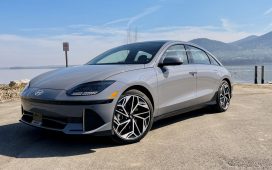Google is rolling out a brand-new high-definition version of Google Maps for cars with the tech giant’s native Android Automotive operating system. The HD maps will provide granular details that were not previously available, like lane markings, road signs, and traffic barriers.
The first vehicles to get the new HD maps will be the Volvo EX90, the Swedish automaker’s new flagship electric vehicle due out later this year, and the Polestar 3, the Volvo-backed performance marque’s first SUV. The Volvo EX90 and Polestar 3 will share the same platform, Volvo’s Scalable Product Architecture (SPA2), and both use Android Automotive, which is Google’s native in-car operating system.
Image: Polestar
Both Volvo and Polestar tout the inclusion of Google’s HD maps as a step toward more precise, safer advanced driver-assistance features. That includes so-called “unsupervised” driving features like Volvo’s Pilot Assist, which the automaker claims will enable drivers to take their hands off the steering wheel and eyes off the road for certain stretches of highway driving.
The first vehicles to get the new HD maps will be the Volvo EX90 and the Polestar 3 electric vehicles
The road data provided by Google’s HD maps, combined with inputs from vehicle sensors like cameras, radar, and lidar, are processed by each vehicle’s Nvidia computing system, which in turn, powers the driver-assist functions.
“Building on our long history of mapping the world, Google’s new HD map is designed specifically for automakers and provides comprehensive lane-level and localization data that is crucial to powering the next generation of assisted and autonomous driving systems,” said Jørgen Behrens, VP and general manager of Geo Automotive, Google, in a statement. “We’re excited to continue partnering with leading automakers like Volvo to improve the safety and comfort of drivers everywhere.”
Image: Volvo
Volvo and Polestar are also rolling out remote check-in capabilities through Google smart home devices. For example, owners can ask Google Assistant to check on their vehicle’s battery levels or to warm up the car from the comfort of their own homes. The function is initially available in the US and will roll out to other markets later in the year.
Google didn’t provide any detail on how it creates its HD maps
Google didn’t provide any detail on how it creates its HD maps, except to say that the feature will only be available to automakers that use Google Automotive Services. According to Google, Google Automotive Services refers to “when a car has Google apps and services like Google Assistant, Google Maps, and the Google Play Store directly integrated into the vehicle so you don’t need your phone to access them.” This is different from Android Automotive, which is a built-in operating system powered by Android software.
Google also noted that Waze, which recently came to a couple of Renault cars with the embedded Android Automotive OS, will reach more vehicles and said it will make the YouTube app available via Google Play “soon.”
Some automakers, like Stellantis, are shipping cars with Android Automotive, but aren’t using Google Automotive Services. The automaker’s Uconnect 5 system that launched on the 2021 Pacifica is powered by Android Automotive. However, Stellantis opted not to use Google’s native apps, instead choosing to use TomTom and Amazon’s Alexa for its mapping and digital assistant functions, respectively.
GM launched a bunch of vehicles with Android Automotive with Google Automotive Services, including the Hummer EV and Cadillac Lyriq. Renault is also launching models in Europe with similar infotainment systems, and Ford has said it is going this direction in 2023.











